About Powell and Monk it has always been pointed out their genius and
innovation in the history of jazz. Unfortunately mental illness has been a disturbing
element for both these extraordinary artists.
Most critics agree that Powell musical output has been more affected by
psychological disorder, if compared to what happened in Monk's oeuvre.
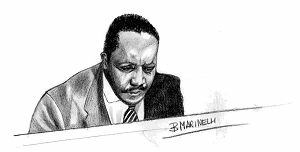 A
point of view about the different styles of playing, is provided by the study of
the "split brain", that is the hemispheres and the brain functions there involved.
A
point of view about the different styles of playing, is provided by the study of
the "split brain", that is the hemispheres and the brain functions there involved.
Powell starts playing chords with his left hand, while the right hand
is used to emphasize improvisation.
This shift in emphasis to the right hand may be linked to the split brain
concept, because right handedness is connected to left brain functions (with the
opposite being true for the left hand in Monk).
Considering these hemispheric differences, it is possible to identify
the areas involved in the cognitive process related to music perception and creation.
Although music is often thought to be the domain of the right hemisphere, some scientists
state that music relies on bi-hemispheric involvement, with the right hemisphere
handling spatial properties (a more global and synthetic comprehension of the musical
composition) and the left side handling the analytic temporal ordering and sequencing
of the individual notes. (the stress is on musical analysis).
According to these hypotheses about cognitive styles and musical creativity,
Powell can be considered "hemispherically" left sided. A confirmation relies on
the fact that he uses his right hand when he improvises. In Powell we immediately
notice an extraordinary ability to play flawless fluent ideas over harmonic extensions.
Approximately we may state that those who prefer Powell to Monk, belong to the "left
side hemisphere" typology.
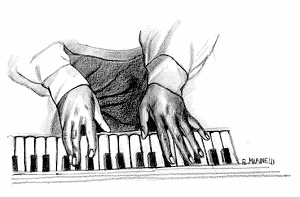 They
should be rational, analytic, linear personalities. To them Powell's style of playing
sounds more satisfying intellectually.
They
should be rational, analytic, linear personalities. To them Powell's style of playing
sounds more satisfying intellectually.
Monk's fans will be more global, intuitive and synthetic. As a matter
of fact Monk's way of playing is mostly based on the right hemisphere of the brain.
As a consequence, his cognitive style is irrational, global and synthetic. Powell's
influence has been far greater when compared to Monk's. This is probably due to
the fact that Monk's inner musical character is very difficult for musicians to
imitate.
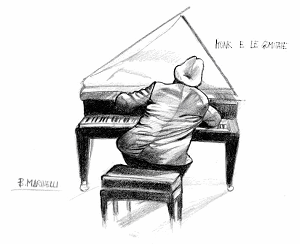 Monk's
stresses the use of the left hand, his phrases are characterized by "wrong" notes,
harmonically off by a half tone so that the tension is increased and then left unresolved.
He often plays two adjacent keys on the piano simultaneously, maximizing dissonance.
He strikes the keys with his flat fingers (instead of bowing them). In particular
moments of elation he shakes the keyboard with his powerful elbows. When he plays
others' compositions, he displaces the tunes, then interpret them again, upsetting
the structure by changing accents and using advances, delays, pauses and swing.
Monk's
stresses the use of the left hand, his phrases are characterized by "wrong" notes,
harmonically off by a half tone so that the tension is increased and then left unresolved.
He often plays two adjacent keys on the piano simultaneously, maximizing dissonance.
He strikes the keys with his flat fingers (instead of bowing them). In particular
moments of elation he shakes the keyboard with his powerful elbows. When he plays
others' compositions, he displaces the tunes, then interpret them again, upsetting
the structure by changing accents and using advances, delays, pauses and swing.
Reflecting on Monk's music, critics have emphasized a sort of childlike
quality and "primitivism". These definitions do not indicate deficiency in modernism,
rather they mirror the originality of his "primordial" musical style, meaning that
it seems to be strictly connected to the origin. Very often his tunes sound like
children's chants while they are at play. They have the same free and reiterative
musical pattern.
Here is what John Coltrane thinks about Monk's intellectual depth
and musical freedom: "You never know what may happen, in the rhythm for instance,
Monk manages to create such a tension, to compel his musicians to "think" rather
than follow the usual clichés. He can start a phrase from a sequence you do not
expect and you have to know exactly what to do. And harmonically he follows different
routes from what you have in mind. But one thing I have learnt from Monk, not to
fear what you really feel."
If we consider again the relation between mental illness and the brain
hemispheres, it is possible to recognize two main types of mental pathologies.
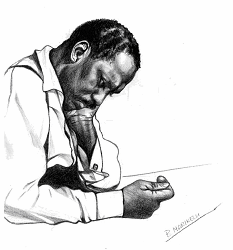 According
to Paudras, the French commercial artist who took care of Powell in Paris
and even later, the pianist was affected by schizophrenia: a part of his personality
encouraged him to solve his problems. He succeeded only when he was among familiar
people, those ones who loved him. At his best he successfully expressed his creative
and interpretative genius. During his states of depression, his performances were
not that good.
According
to Paudras, the French commercial artist who took care of Powell in Paris
and even later, the pianist was affected by schizophrenia: a part of his personality
encouraged him to solve his problems. He succeeded only when he was among familiar
people, those ones who loved him. At his best he successfully expressed his creative
and interpretative genius. During his states of depression, his performances were
not that good.
Monk's madness was much more naïve. Monk was not as provocative and belligerent
as Powell was sometimes, but in his naiveté, Monk's eccentricities were many.
His bi-polar personality manifested in moments of elation; in his Parisian
concerts he used to stop playing and get up. Then he would start dancing to the
music, his mountain-like figure shuffling and spinning to the rhythm, while musicians
improvised. Then he miraculously returned to the piano, when the soloist finished
and he started playing exactly where he had to. He said he did it to realize if
the music worked out.
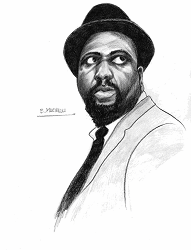 On
the contrary there were periods of inactivity when he stayed in bed continuously
"laying dead". He did not talk to anyone, practically mute, in a catatonic
state. "It is always night. If it were not so, we would not need light so much."
It was his favourite aphorism.
On
the contrary there were periods of inactivity when he stayed in bed continuously
"laying dead". He did not talk to anyone, practically mute, in a catatonic
state. "It is always night. If it were not so, we would not need light so much."
It was his favourite aphorism.
Both Powell and Monks were hospitalized for mental illness, but Monk only
under observation.
He had been seen wandering,at night at the airport in Boston. His behaviour
seemed unusual and eccentric; when the policemen approached him, he refused to communicate
and kept silent.
The doctors who examined him, concluded that he had only a paranoiac disposition
and he was discharged from hospital.
Powell was hospitalized for longer periods. His personality was extremely
remote and he developed a passive attitude towards life events. On the contrary
Monk showed an absolute indifference towards what he was surrounded by. Even when
fame reached him in America and Europe, his life did not change significantly. He
maintained his ordinary standard lifestyle, in his apartment situated in San Juan
Hill, New York. He only moved to baroness Nica's, during the last period of his
life.
Powell and Monk befriended when they were very young. Powell was just
17, Monk 24.
Monk had already realized that his friend was accepted neither as a musician,
nor as a human being. He sympathized with him for both aspects. He became his mentor.
To remember the close friendship between them, here is an excerpt from
"Dance of the Infidels", Powell's biography written by Francis Paudras.
The author recalls one of their encounters, after they have been so far
away for a long period. They are now famous and Powell has just come back to New
York after his Parisian stay. Bud and Paudras go to Monk's. It's early afternoon.
"I rang the bell, we waited a while and were about to leave when the door
opened and there stood Thelonious himself, a towering silent figure. I had stepped
behind Bud and now they were face to face, their faces nearly touching.
They stood there as if hypnotized for what seemed an eternity without
a word or a movement. Nothing in their faces betrayed the slightest sentiment. Just
as I was beginning to think no one would ever move, Thelonious took Bud by the shoulders
and pushed him to the apartment, uttering the enigmatic words, " Come on in, I'll
do the airplane!"
At his Paris concerts we had gotten used to his strange wanderings
around the stage while the musicians improvised their choruses: with his stumbling
gait, he would venture very close to the edge, just over the orchestra pit, keeping
time to the music with jerky movements of his whole body, while holding his arms
straight out like a child imitating an airplane. Sometimes he would pretend to fall
off the stage, giving the front row spectators a bit of scare. "I'll do the airplane!"
At that moment, the words seemed so out of place I wasn't sure I'd heard him right.
Thelonious led the way, with Bud behind him. We entered a small room
taken up by an immense grand piano, which looked even larger for the lack of space
and more peculiar for the pile of dishes lying on its lid. The back of the piano
was in the kitchen and the keyboard in the living room. Thelonious sat right down
to play, lifted his hands high over the keys, looked down at his feet and pressed
down both pedals. With a slow, extremely calculated movement, he pressed down hard
on the keys and remained like that, head down, back bent over, body pressed against
the keyboard until the sound faded away.
First the piano let out a row rumble and the dishes began to shake
until they started vibrating with the resonance of the strings. The density of the
sound imitated to perfection the roar of a formation of bombers. Suddenly, it brought
to mind a very precise memory. During the war, when there were air raids, we would
listen for the American Superfortresses coming in to bomb the German positions.
Flying very high to get above the anti-aircraft fire, they produced a low, dull,
very distinctive sound that no one who lived through that period ever forgot. It
was this sound that Thelonious had just reproduced. The roar died away like the
planes moving off as Thelonious sat there, still bent over, and turned his head
slightly to give Bud a questioning look. Repressing a smile at first, Bud finally
burst into guffaws of laughter that brought tears to his eyes………"
Bud Powell died in 1966 in New York.
He was only 45. Monk later in 1982, he was 64.
He was living at Nica's, in her splendid home in New Jersey. He spent the last period
lying in bed. Probably he had not anything else to say. By the way he had once stated
in an interview "I don't speak so much because it's impossible to tell everyone
what you're thinking about. Sometimes we do not even know what we are thinking about."

